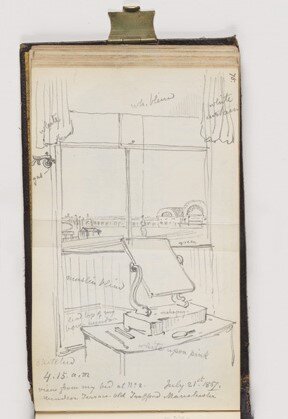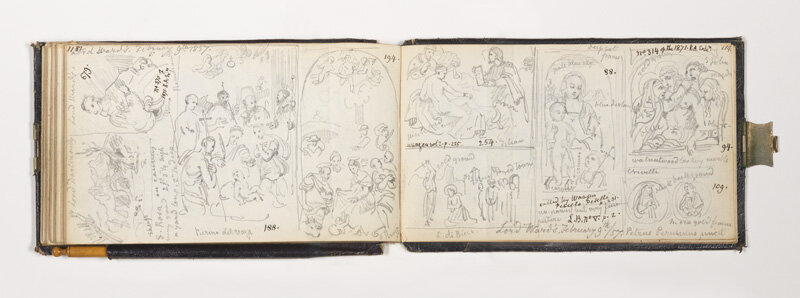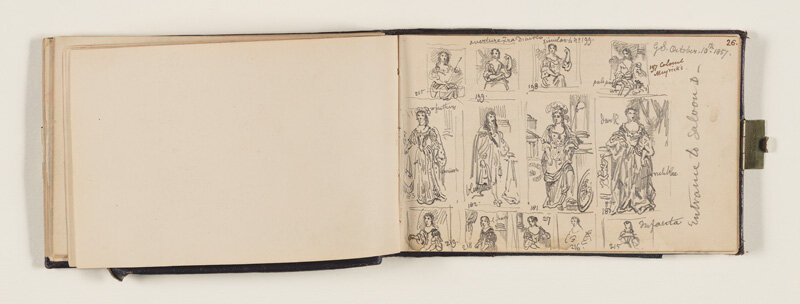Sir George Scharf (1820-1895) looms large in the history of the National Portrait Gallery. Appointed Secretary 1857 and then created Director in 1882, he was instrumental in the Gallery’s early development. Indeed, Trustees deemed him a model of ‘unflagging zeal and industry’. He was a trained artist, an enthusiastic antiquarian, and a meticulous record creator. The Gallery’s Archive holds a substantial collection of his papers and at their core are over two hundred volumes of pocket sketchbooks, densely populated with drawings, notes and references. A new digital resource draws on a discreet set of sketchbooks documenting Scharf’s work for the 1857 Art Treasures of Great Britain exhibition, prior to joining the Gallery. If your research intersects with old master artworks, private art collections, public exhibitions or social history of this era, please explore the digital offer at https://www.npg.org.uk/research/scharf-sketchbooks/
Scharf and the Art Treasures exhibition
MGHG members are doubtless familiar with the famous Art Treasures exhibition. Staged in Manchester May-October 1857, it was a landmark in scale and approach to public art appreciation, using classification and chronological arrangement to promote understanding of successive periods and schools of art. Over 16,000 exhibits in diverse media drew more than 1.3 visitors to the specially constructed Art Treasures Pavillion at Old Trafford (fig. 1).
Scharf was Art Secretary to the exhibition. He also curated its Ancient Masters section, for which he sourced 1,200 loaned works. He secured these loans with characteristic diligence, visiting more than one hundred collections, and recorded his efforts in sketchbooks (fig. 2). In Scharf’s own words, he documented ‘an ideal gallery on paper, taking the choicest specimens of every master in the history of art, as far as I remembered their existence in this country.’ The data Scharf recorded for old master artworks in British private collections drew Dr Philip Cottrell of the School of Art History and Cultural Policy, University College Dublin, who recognized the sketchbooks’ immense research potential. Volumes analysed by the recent project are full of notes and images. Scharf recorded artworks and their environs during his rail-enabled travels to locations in England, Scotland and Wales. He also documented his visits to the finished exhibition, making studies of works on display and a number of ‘wall maps’ recording sections of the chronological hang (fig. 3).
A new digital resource
Dr Cottrell led The George Scharf Manchester Art Treasures Sketchbooks project, funded by The Samuel H. Kress Foundation, The Paul Mellon Centre for Studies in British Art, and The Thomas Dammann Junior Memorial Trust. Dr Cottrell and the National Portrait Gallery collaborated to deliver the recently launched online resource, and it is one Scharf would have found invaluable. He peppered his physical records with handwritten cross-references, attempting to achieve on paper something much more feasible in the digital age. Thanks to the project, digital images of sketchbook pages are available online alongside detailed database entries created by Dr Cottrell. Users can search by keyword or Art Treasures catalogue number. Entries draw together valuable information on provenance, the contents of Victorian private collections (many subsequently disbursed), and the present day location of artworks, where known.
Scharf and his papers at the National Portrait Gallery
For those curious about Scharf and his legacy, the digital resource also includes an introductory guide to his papers at the National Portrait Gallery Archive.
Any who venture further will find his Art Treasures sketchbooks one thread of a far richer seam. Scharf’s artistic skill renders his sketchbooks particularly appealing. One discreet sequence contain sketches of his travels to sites in Asia Minor with the 1839-1844 archaeological expeditions of Sir Charles Fellows. The wider run of his personal sketchbooks initially reflect the development of his draughtsmanship, then navigate his time as a lecturer, researcher and teacher of art, and following his appointment at the National Portrait Gallery contents increasingly reflect his portrait research and surveys of art collections public and private. A separate sequence of Trustees’ sketchbooks document portraits offered to the Gallery for acquisition and collections Scharf surveyed in an official capacity. Contents throughout reflect Scharf’s lived experience. His renderings of artworks are interspersed with sketches of everyday scenes, architecture, and even dogs in fancy dress(!)
Beyond his sketchbooks, Scharf’s meticulous approach to research, note taking and diary keeping offer much to historians of his era. His papers are a splendid resource for scholars of museum history, offering considerable insight into the early development of the National Portrait Gallery in particular. Known as ‘The Father of the Gallery’, Scharf oversaw diverse areas of activity as the institution grew, including visitor access and the development of research resources. He influenced the formation of the portrait Collection and established an institutional acquisition methodology rooted in portrait research, aspects of which still inform current practice. His contribution to the curatorial field has been the subject of recent study: Elizabeth Heath examined the advancement of his professional approach in her 2018 doctoral thesis ‘Sir George Scharf and the early National Portrait Gallery: reconstructing an intellectual and professional artistic world, 1857–1895’. This interrogated Scharf’s personal and professional networks, emphasizing his place in an emerging professionalization within the field, an approach combining rigorous, academic research with public service impulse. His institutional impact is evident in National Portrait Gallery’s Archive & Library. Scharf began all of the collections that specialist staff across curatorial, library and archive spheres maintain today. He laid the foundations of the institutional archive and established sequences of reference images, built up a working Library, and accumulated primary sources. These resources assisted him in his wide-ranging role and created an invaluable legacy for future staff and visitors to the Archive & Library. Descriptions of Scharf’s papers, and thousands of other records in the Gallery’s archives, are available via the online Archive Catalogue: http://archivecatalogue.npg.org.uk/CalmView/
Bryony Millan, Senior Archive & Library Manager at the National Portrait Gallery and MGHG Treasurer.
Further reading
Cottrell, Philip, ‘Art Treasures of the United Kingdom and the United States: The George Scharf Papers’, The Art Bulletin Vol. 94, No. 4 (December 2012) https://www.jstor.org/stable/43188780?seq=1#metadata_info_tab_contents [accessed 12 December 2019]
Heath, Elizabeth, (2018) Sir George Scharf and the early National Portrait Gallery: reconstructing an intellectual and professional artistic world, 1857–1895. Doctoral thesis (PhD), University of Sussex/National Portrait Gallery http://sro.sussex.ac.uk/id/eprint/73230/ [accessed 12 December 2019]
Heath, Elizabeth, ‘A man of ‘unflagging zeal and industry’: Sir George Scharf as an emerging professional within the nineteenth-century museum world’, Journal of Art Historiography 18 (June 2018) https://arthistoriography.wordpress.com/18-jun-18/ [accessed 12 December 2019]
National Portrait Gallery, ‘Sir George Scharf 1820-1895: Director, Researcher, Victorian Socialite’ https://www.npg.org.uk/research/archive/archive-journeys/sir-george-scharf/ [accessed 12 December 2019]
Image captions
fig. 1. NPG7/3/4/2/54/38, view of the Art Treasures Palace from the window of Scharf’s Old Trafford lodgings, Jul 1857. Scharf sketchbook 46 (National Portrait Gallery, London).
fig. 2. NPG7/3/4/2/53/60, notes and sketches on works of art in the collections of William Walter Legge, 5th Earl Dartmouth of Grosvenor Square and Lord Ward's Gallery, Piccadilly, London, Feb 1857. Scharf sketchbook 45 (National Portrait Gallery, London).
fig. 3: NPG7/3/4/2/59/26, sketch of part of the Art Treasures hang (British Portrait Gallery, back of Saloon D), made in situ at the Art Treasures Exhibition, Manchester, October 1857. Scharf sketchbook 49 (National Portrait Gallery, London).


